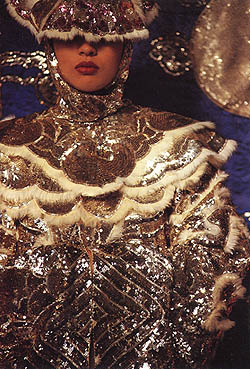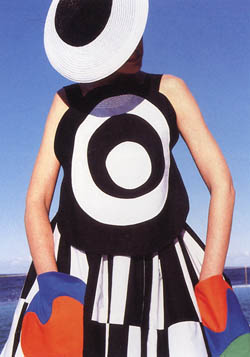|
Lisa
Ho: costumes for the 2000 Olympic Games Opening ceremony
Lisa Ho is one of Australia's most popular fashion designers
and manufacturers, best known for her beaded evening
wear, comfortably cut jeans and more recently glamorous
swimwear.
With
a family background in tailoring and sewing, Lisa Ho
knew at an early age that she wanted to create clothing.
She studied dress design at East Sydney Technical College
and established her eponymous label soon after graduation.
Lisa
Ho was one of four fashion and costume designers approached
to create original costumes for the Arrivals
segment of the Sydney 2000 Olympic Games opening ceremony.
The designers were asked to express the rich cultural
heritage that migrants from around the world have brought
to Australia. Lisa Ho was given the Asia region and
sought through her designs to explore the rich costume
and textile traditions of the diversity of cultures
in this area. Rather than taking the styles literally
she has transformed them into a very evocative but contemporary
manifestation.
For
more information on Lisa Ho:
www.lisaho.com
Jenny
Kee
Jenny Kee was born in Bondi in the late 1940s to a Cantonese
father and Italian-British mother. She made her way
to swinging London in the mid 1960s and made
the most of the creative bohemian atmosphere, landing
a job at the Chelsea Antique market where she sold and
dressed herself in an eye catching mix of ethnic and
retro clothes. On returning to Australia in the early
1970s she decided to set up the Flamingo Park
frock salon in the Strand Arcade selling retro garments
and the work of avant-garde Australian designers including
Linda Jackson and Peter Tully.
Jenny
also began to create her own unique knitwear and printed
cotton and silk garments. Her work drew not only on
her love of Australia's unique natural environment and
in particular its cycles of death and regeneration,
but also on the silhouettes and textiles of traditional
Asian clothing. Overlaying this was a spiritual quest
which drew on Asian religious philosophy and practice,
in particular yoga, meditation and Buddhism.
Her
work drew on her experience of living in the Blue Mountains
in a home surrounded by native bushland which is frequently
ravaged by fire. From the devastation she has watched
the bush regenerate with a showing of green shoots,
leaves and flowers even more spectacular after their
ordeal. Her waratah and black boy fabric was
inspired by this process, with the rich reds of the
waratahs criss-crossed by the black stalks of the black
boy (colloquial term used for any species of plant
belonging to the genera Xanthorrhoea and Kingia
- thought to resemble a native figure with a grass skirt
holding a spear). Jenny used the colour red extensively
in her work because of its connection to her Chinese
background and because it was the colour of both fire
and the waratah, a colour related to both destruction
and regeneration.
Many
of her silhouettes were inspired by Asian dress, she
was primarily attracted to the comfort, ease and elegance
afforded by styles such as the aoku with its
pyjama style top and pants, the cheungsam, the
kimono sleeve and mandarin collar.

Jenny Kee opal print, aoku inspired
outfit. Courtesy: Jenny Kee. Powerhouse Museum Collection.
|

Waratah and black boys
inspired dressing gown, swimming costume and cheungsam
(Powerhouse Museum, 1989: 5) Courtesy: Jenny Kee.
|
Linda
Jackson
Linda Jackson is one of Australia's most significant
designer-makers. In the early 1970s Jenny Kee opened
the Flamingo Park frock salon and filled it with
Linda Jackson's original garments, beginning a highly
successful and influential collaboration which lasted
ten years. Linda continued with her own design business
Bush Couture and has more recently been designing furnishing
fabrics for Australian resorts.
Linda
Jackson's designs are closely linked to oriental and
tribal dress, and an integration of art, life and environment.
An interest in Buddhism and travels in Asia led to the
collecting of exotic textiles and Chinese Opera costumes.
Drapes
and patchwork inspired from Monk's robes, the intricate
layering and decoration combined with the flat shapes
of the Opera costumes inspired a unique translation
of Chinese dress - the flat shape becoming the canvas
for a poetic vision of Australian symbols.
In
Kuala Lumpur, I met a Chinese family, one of whom
had been an opera singer in Shanghai during the twenties
and thirties. All her costumes were lovingly preserved
in a trunk. Most of them were traditional in shape;
there were skirts that were flat in the front and
pleated up the side, small bodice tops, and wide,
flat coats and jackets with big sleeves. Enormous
care had gone into decorating them. Some were embroidered
in gold thread on the collar and sleeves, some glittered
with sequins, others were encrusted with small coloured
beads. All, of course, were handmade. They were absolutely
beautiful. (Jackson, 1987: 135)

1920s Chinese opera costumes from
Shanghai, with Chinese stage curtain backdrop. (Jackson,
1987: 134) Photo by: Linda Jackson. Courtesy: Linda
Jackson. Powerhouse Museum Collection.
|
The
strongest examples of where Chinese dress has influenced
Linda Jackson's designs can be seen in the following
garments:
Black
Banksia (1986) was inspired by opera costumes that
feature several pieces that are layered and tied individually
onto the wearer's body.

Black banksia, 1986. (Jackson, 1987:
91) Photo by: Linda Jackson. Courtesy: Linda Jackson.
Powerhouse Museum Collection. |
Wildflowers
applique (1976) features the flat Chinese top shape
decorated with wildflowers.

Wildflowers applique, 1976. Cotton
applique Chinese top and dirndl skirt, featuring
anthuriums, gum blossom, Sturt's desert pea and
birds of paradise. Matching headscarf in batik.
Collection of the Australian National Gallery, Canberra.
Photo by: Linda Jackson. Courtesy: Linda Jackson.
|
Abstract
Patchwork (1977) features flat Chinese top shape
and collar. The large flat Chinese shape is cut out,
then squares and strips of coloured cotton are arranged
as a painting, then stitched together, the original
shape becomes the lining.

Abstract Patchwork, 1977. (Jackson,
1987: 36) Photo by: Linda Jackson.
Courtesy: Linda Jackson.
|
The
circular top of The Black and White Disc (1979) was
inspired by women's under layers.

The Black and White Disc, 1979.
The art of the disc, spheres cut and appliqued onto
each other to create a circle top. (Jackson, 1987:
34) Photo by: Linda Jackson. Courtesy: Linda Jackson.
|
s
|